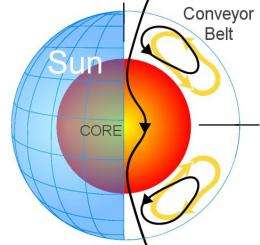March 15, 2010 report
Study may explain the extended solar minimum

(PhysOrg.com) -- The recent solar minimum extended fifteen months longer than predicted, and a new study may explain why, and improve the predictions for future solar cycles.
The solar minimum at the end of each 11-year solar cycle is characterized by a reduction in the number of sunspots, flares, and other solar activity. The most recent, from 2008 to the beginning of 2009, lasted fifteen months longer than expected.
The study used 13 years’ worth of results from SOHO, the Solar and Heliospheric Observatory, which was launched jointly by the European Space Angency and NASA. Among the data gathered by SOHO are measurements of the ionized gases moving from the sun’s equator to the poles in what is known as the meridional flow. The scientists then tried to correlate the flow with variations in the sunspot cycle.
The researchers, Lisa Rightmire of the University of Memphis, Tennessee, and David Hathaway of the Marshall Space Flight Center in Huntsville, Alabama, found the normally slow meridional flows started to speed up a few years before 2008, when the number of sunspots declined. In the previous solar minimum the speed was around 30 kph, but in 2008-9 was about 47 kph. The scientists suggest the solar minimum was longer than usual because the magnetic fields produced by the gas flows at the poles were weaker, but it is not known why the speed of the meridional flow increased.
Hathaway said the meridional flow carries with it magnetic fields that oppose the flows of strongly magnetized material on the solar surface. When the meriodional flow is faster the opposition to the other flows is greater and the polar magnetic field cannot become as strong as it otherwise would, and this may have delayed the start of the current solar cycle that began in 2009. Hathaway said the strength of the magnetic flow at the poles is critical since the magnetic fields fall below the surface and set up the conditions for sunspots, and when the fields are weaker they take longer to reach the required strength to produce sunspots. Hathaway and Rightmire also predict the current solar cycle is likely to have less solar activity than the previous cycle.
The results of the study, published in Science, may improve the forecasting of the duration and intensity of solar cycles in the future, and this could be valuable since some solar activity can create magnetized clouds of charged particles that can damage orbiting satellites and disrupt power grids on Earth. Improved predictions of solar cycles could also help climate scientists with their long-term predictions. The results also suggest that models predicting that a fast meridional flow would lead to a stronger magnetic field at the poles, may have to be revised.
More information: Variations in the Sun’s Meridional Flow over a Solar Cycle, David H. Hathaway and Lisa Rightmire, Science 12 March 2010: Vol. 327. no. 5971, pp. 1350 - 1352, DOI:10.1126/science.1181990
© 2010 PhysOrg.com





















